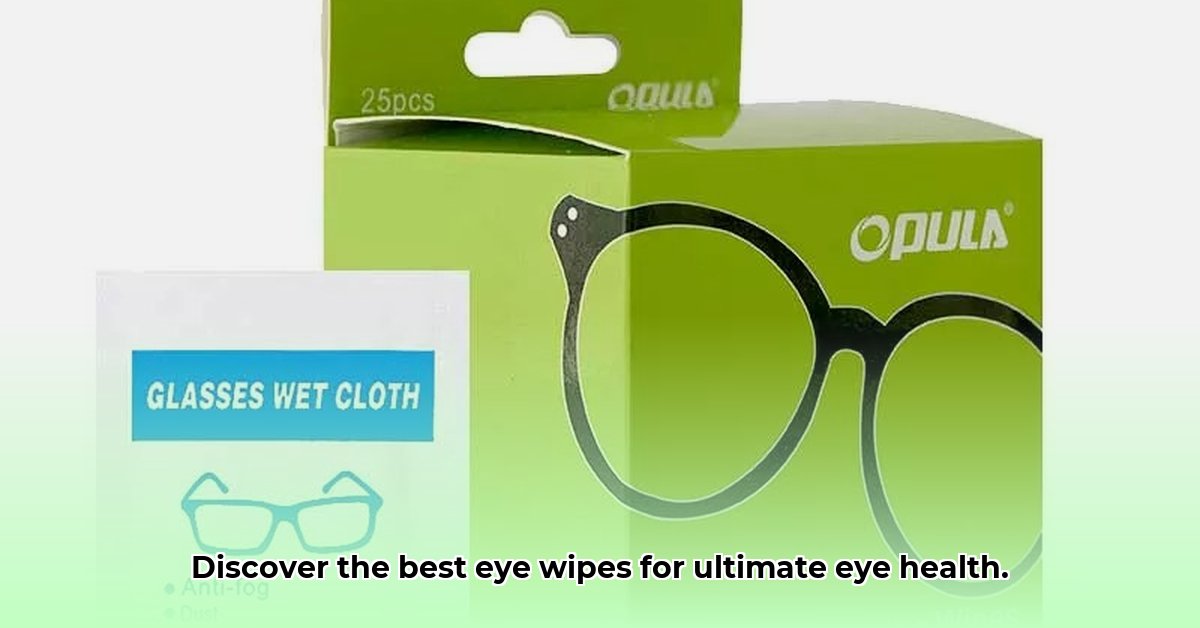Are you struggling with dry eyes, blepharitis, or simply seeking cleaner, healthier eyelids? Eyelid wipes can be a transformative addition to your eye care routine. This article provides a comprehensive guide, breaking down the complexities of choosing the right wipes for your specific needs. We’ll delve into popular brands, explain essential ingredients (and those to avoid), and guide you through proper usage techniques. Whether you’re managing blepharitis or aiming for optimal eye health, we’re here to help you discover the perfect wipes. Dive in to unlock the secrets to healthy, happy eyes! For more information on eye care wipes, check out [this helpful resource](https://chaztin.com/eye-care-wipes/).
Eyeness Wipes: Your Guide to Healthy, Happy Eyes and Optimal Ocular Hygiene
Let’s explore the world of eye wipes, focusing on eyelid wipes like Eyeness, designed to offer your eyes the care they deserve. These wipes are gaining popularity as a convenient method to maintain clean and healthy eyelids, which can be particularly beneficial if you’re prone to dry eyes, blepharitis (eyelid inflammation), or simply want to enhance your eye hygiene. Are you ready to discover the path to healthier, happier eyes? Studies suggest that approximately 30% of adults experience some form of blepharitis, underscoring the importance of effective hygiene practices.
How Eyeness Wipes Work Their Magic for Enhanced Eye Comfort
Consider eyelid wipes as a gentle, daily spa treatment for your eyelids. They effectively remove accumulated dirt, makeup, oils, and debris, which can cause irritation and potentially lead to conditions like blepharitis. Many wipes contain soothing ingredients that actively reduce irritation and inflammation. Some formulations even include antibacterial agents to minimize the risk of infection. The simple act of gently wiping away irritants can significantly improve comfort and eye health, providing a soothing and revitalizing sensation.
Navigating the World of Eyelid Wipes: Types, Key Ingredients, and Proper Application
The realm of eyelid wipes offers a variety of options. You’ll discover wipes suitable for daily use, providing general cleansing and maintenance, as well as specialized formulations designed to manage conditions like blepharitis. Ingredients can vary considerably, from natural plant extracts to synthetic compounds. Selecting the right wipe involves understanding your individual needs and preferences.
Here are some common ingredients you’ll likely encounter:
- Tea Tree Oil: Renowned for its natural antibacterial properties, tea tree oil can effectively combat bacteria that contribute to eyelid infections. However, it may cause irritation for some individuals with sensitive skin. It’s advisable to perform a patch test on a small area of skin before applying it to your eyelids.
- Chamomile: With its soothing and anti-inflammatory properties, chamomile can help calm irritated and inflamed eyelids. It’s a gentle option, especially suitable for those with sensitive eyes.
- Aloe Vera: A popular ingredient for soothing irritated skin, aloe vera is known for its ability to reduce inflammation and promote healing. Its gel-like consistency also helps to keep the area moisturized.
- Hyaluronic Acid: This ingredient helps to hydrate the skin around the eyes, which can alleviate dryness and discomfort.
- Saline Solution: Some wipes use a saline solution as the primary cleansing agent. Saline is gentle and mimics the natural salt content of tears.
- Other Ingredients: You may also find ingredients like calendula, green tea extract, or various vitamins. These components are often added for their moisturizing or anti-inflammatory effects. Always carefully review the label to understand the complete ingredient list.
Comparing Eyeness Wipes and Other Brands: A Head-to-Head Look at the Top Competitors
Choosing the right eyelid wipe can be a challenge, so let’s explore some popular brands. Keep in mind that individual experiences can vary, and what works well for one person may not be ideal for another. Have you ever wondered which brand offers the optimal balance of ingredients and effectiveness?
| Brand | Key Ingredients | Pros | Cons | Our Rating (out of 5) |
|---|---|---|---|---|
| Eyeness Wipes | Tea Tree Oil, Chamomile, Aloe Vera | Gentle, effective cleansing, soothing; often good for sensitive skin. | May be slightly more expensive than some alternatives. | 4.5 |
| Ocusoft Lid Scrub | Docusate Sodium, PEG-200 Hydrogenated Glyceryl Palmate | Clinically proven for blepharitis management. | Some users may find the scent or texture unpleasant. | 4.0 |
| Systane Lid Wipes | PEG-8, Polysorbate 20 | Preservative-free and gentle. | May not be strong enough for heavy makeup removal or severe blepharitis. | 3.8 |
| We Love Eyes | Tea Tree Oil, Aloe, Castor Oil | Vegan and cruelty-free options available. | Tea tree oil can be irritating for some. | 4.2 |
| Cliradex Light Wipes | 4-Terpineol (from Tea Tree Oil) | Concentrated tea tree oil component, effective for Demodex mites. | Can be quite strong and potentially irritating; use with caution. | 3.5 |
(Note: The actual ingredients and ratings may differ. Consult product packaging for the most up-to-date information. Ratings compiled from user reviews and ingredient analysis.)
The Science Behind the Swipes: Understanding Efficacy, Safety, and Clinical Studies
While many individuals report positive experiences with eyelid wipes, ongoing clinical research continues to explore their effectiveness. Extensive, large-scale studies are needed to provide definitive proof of their efficacy in treating specific eye conditions. However, for daily cleansing and managing mild blepharitis symptoms, many find them to be a beneficial tool.
Prioritize safety at all times. Discontinue using any eyelid wipe immediately if you experience irritation, redness, burning, or an allergic reaction. If symptoms persist or worsen, consult an ophthalmologist or your healthcare provider. A study in the Journal of Ophthalmology showed that regular use of eyelid wipes containing tea tree oil significantly reduced Demodex mite counts in patients with blepharitis.
Using Eyelid Wipes: A Step-by-Step Guide for Optimal Results and Eye Protection
Proper usage is critical for both effectiveness and safety. Follow these steps:
- Clean Hands: Thoroughly wash your hands with soap and water to prevent the transfer of bacteria to your eyes.
- Open and Prepare: Gently remove a single wipe from its packaging, ensuring it remains sanitary.
- Gentle Cleansing: Close your eyes and gently swipe the wipe across your eyelids, moving from the inner corner towards the outer corner. Avoid harsh rubbing or excessive pressure.
- Disposal: Dispose of the used wipe immediately and properly to maintain hygiene.
5 Frequency: Use as directed, typically 1-2 times daily, or as recommended by your eye doctor.
Always adhere to the manufacturer’s instructions printed on the product label.
Finding the Perfect Wipe: Making the Right Choice for Your Unique Eye Condition
The ideal eyelid wipe depends on your individual needs and preferences. Consider factors such as sensitive skin and pre-existing conditions like blepharitis or dry eye syndrome. Reading customer reviews and carefully examining the ingredient list can help you make an informed decision.
Eyelid wipes are a convenient method for maintaining eyelid hygiene. However, they should not replace regular eye exams or other essential eye care practices recommended by your eye doctor. They can be a valuable component of a comprehensive eye care routine but are not a standalone solution. They are one tool in your eye care toolkit.
How to Choose the Best Eyelid Wipes for Optimal Blepharitis Management Based on Clinical Evidence and Expert Recommendations
Key Takeaways:
- Eyelid wipes offer a convenient approach to eyelid hygiene, potentially alleviating blepharitis symptoms.
- Scientific evidence supporting the superiority of any specific brand or formulation is still evolving. Further research is warranted.
- Individual responses can vary considerably. What proves effective for one person may not be suitable for another.
- Always consult with your eye care professional for personalized recommendations.
Understanding Blepharitis and the Role of Eyelid Wipes in Alleviating Discomfort
Blepharitis, characterized by inflammation of the eyelids, can be a frustrating condition. Common symptoms include itchy, red, and irritated eyelids, which can impact daily life and vision. Eyelid wipes are gaining traction as a supplementary approach to managing this condition. But how effective are they, and how do you select the best eyelid wipes for blepharitis based on clinical evidence? Let’s delve into the details. The prevalence of blepharitis is estimated to be as high as 50% in some populations, indicating a significant need for effective treatment options.
How Eyelid Wipes Work: Gentle Cleansing Mechanisms and Anti-Inflammatory Properties
Eyelid wipes function by gently removing debris, bacteria, and makeup that can exacerbate blepharitis. This cleansing action helps reduce inflammation. Many formulations contain ingredients with antimicrobial properties, such as tea tree oil, which further combat inflammation. It’s akin to providing your eyelids with a refreshing and therapeutic cleanse. The mechanical action of wiping also helps to physically dislodge debris and oil buildup.
Choosing Your Eyelid Wipe: A Detailed Look at Ingredient Analysis and Brand Comparison
Selecting the right eyelid wipe requires careful consideration. Different
- Bento Box Trays Streamline Restaurant Meal Presentation and Transport - December 13, 2025
- Plastic Bento Boxes Face Scrutiny Over Sustainability Impacts - December 11, 2025
- Bento Tray Revolutionizes Organized Meal Transport and Presentation - December 10, 2025










